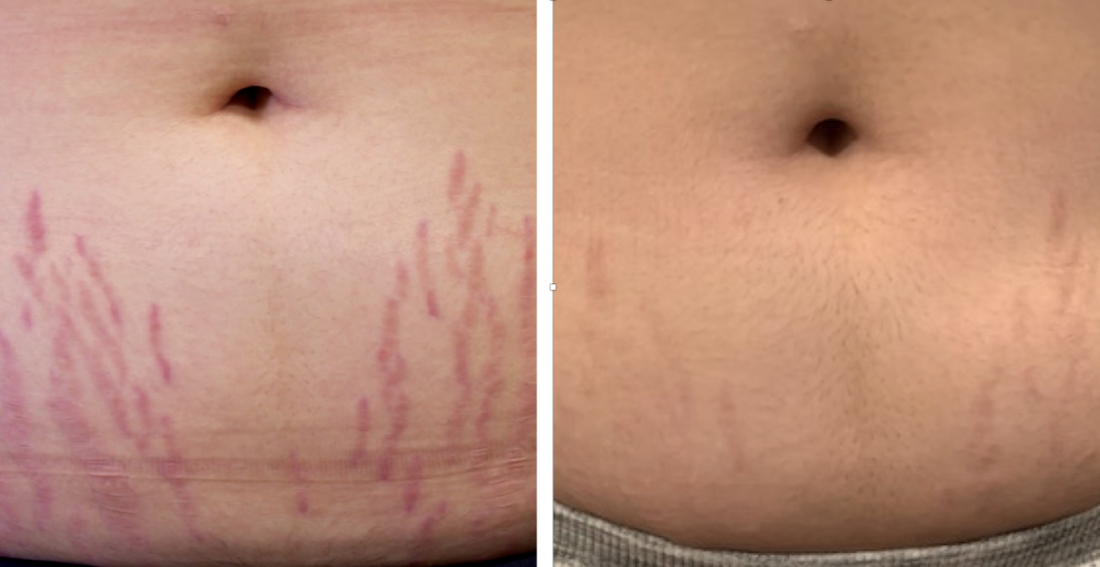Every woman who has had a baby and anyone who has been on a crash diet is familiar with stretch marks. Known by doctors as striae distensae, stretch marks are unsightly, narrow bands of striated scar tissue underneath the epidermis – the topmost layer of your skin – that develops when skin tears as it stretches or contracts too quickly. Stretch marks are very common and nothing to worry about, but they can make you feel less confident about wearing shorts, sleeveless tops or your swimsuit.
When skin stretches or shrinks too quickly, the collagen and elastin in the dermis – the middle layer of the skin – ruptures then heals creating narrow bands of scar tissue that are a different color from the skin around it. When they first show up, stretch marks can be red, dark brown, reddish-brown, or purple, and they may feel a little lumpy and even itchy. The color of your stretch marks will depend on your skin tone. Over time, the color will fade and what will be visible are unattractive striations under the epidermis. Once a stretch mark matures, you may feel a slight depression on the area of the scar tissue.
Here are some of the top reasons we get stretch marks and some tips on how you can make them less visible.
The most common reasons for stretch marks are:
1) Rapid weight loss and weight gain
2) Pregnancy
3) Fluctuating hormone levels
4) Genetics
5) Bodybuilding or
6) Prolonged use of corticosteroids
Causes of stretch marks on lower back
Stretch marks commonly appear around the thighs, buttocks, and inner arms, but they can show up on various parts of your body. Stretch marks on the lower back often first appear as reddish or purplish horizontal lines that look like ladder rungs or tiger stripes, and may be a little tender or itchy. As they mature, they take on a more white or silvery color. One of the common causes of stretch marks on the lower back is rapid weight gain. Other causes include pregnancy, muscle gain from weight lifting, genetics, overuse of corticosteroid medications, stress, or health conditions such as Cushing syndrome and Marfan syndrome.
Causes of stretch marks in pregnancy
Up to 90 percent of pregnant women will get stretch marks and they’ll likely show up across the belly, thighs, breasts, buttocks or hips during the end of the second trimester or the beginning of the third. Genetics plays a role in the development of stretch marks so women whose mothers have stretch marks have a higher likelihood of getting them too. Weight gain in pregnancy increases the chances of developing stretch marks, so maintaining a healthy weight is important. Some studies have found that regular massaging and moisturizing of stretch marks with vitamin and essential oils can help prevent stretch marks by promoting healing and cell repair.
Causes of stretch marks in males
It’s not just women who get stretch marks. Men get them as well and the most common reasons are growth spurts during puberty, rapid weight gain that causes abdominal stretch marks, and bodybuilding, which causes the skin around the muscles to stretch as they grow. Growth spurts at puberty is a common cause of stretch marks in males because when male bodies grow too fast, they may be unable to produce enough collagen to maintain elasticity. Obesity and weight gain in men usually leads to the accumulation of subcutaneous fat around the abdominal area, and this causes vertical stretch marks to appear around the belly. Bodybuilding stretches the skin as muscles bulk up and this can trigger stretch marks along the perimeter of the muscle.
Medical treatments for stretch marks
While stretch marks are extremely common, and harmless, people who want to get rid of their stretch marks can do so with medical aesthetic treatments that will help the skin produce more collagen to fade away the marks. These treatments include pulsed dye laser therapy, which uses light energy to calm blood vessels under the skin around the stretch marks, fractional CO2 laser therapy, which may be able to smooth out mature, white stretch marks, and excimer laser therapy that uses ultraviolet light to correct pigment-related stretch mark problems. Radiofrequency which use radio wave energy – and ultrasound therapy – which sends sound waves deep into the skin – can encourage the body to produce more collagen to reduce or eliminate stretch marks.
Non-invasive treatments
Aesthetic treatments may not be for everyone, and those who do not want medical therapies can still reduce the appearance of stretch marks with the right skin care products. K&K Skin Product’s Stretch Mark Eraser Kit can improve skin tone, tighten skin, and reduce the size and appearance of stretch marks. Lovingly crafted in New Mexico, the Kit includes K&K’s After Shower Body Serum, BioVer-X™️ Enhanced Antioxidant Serum, Revitalize Healing Hydration, and a premium Bamboo Washcloth. Ingredients in the serums and moisturizer include the brand’s potent BioVer-X™️ molecule, golden jojoba, sweet almond, tea tree, rosemary, frankincense and soothing lavender oil, Vitamin E, and shea butter, all of which have powerful healing properties that can help make stubborn stretch marks fade or disappear.

